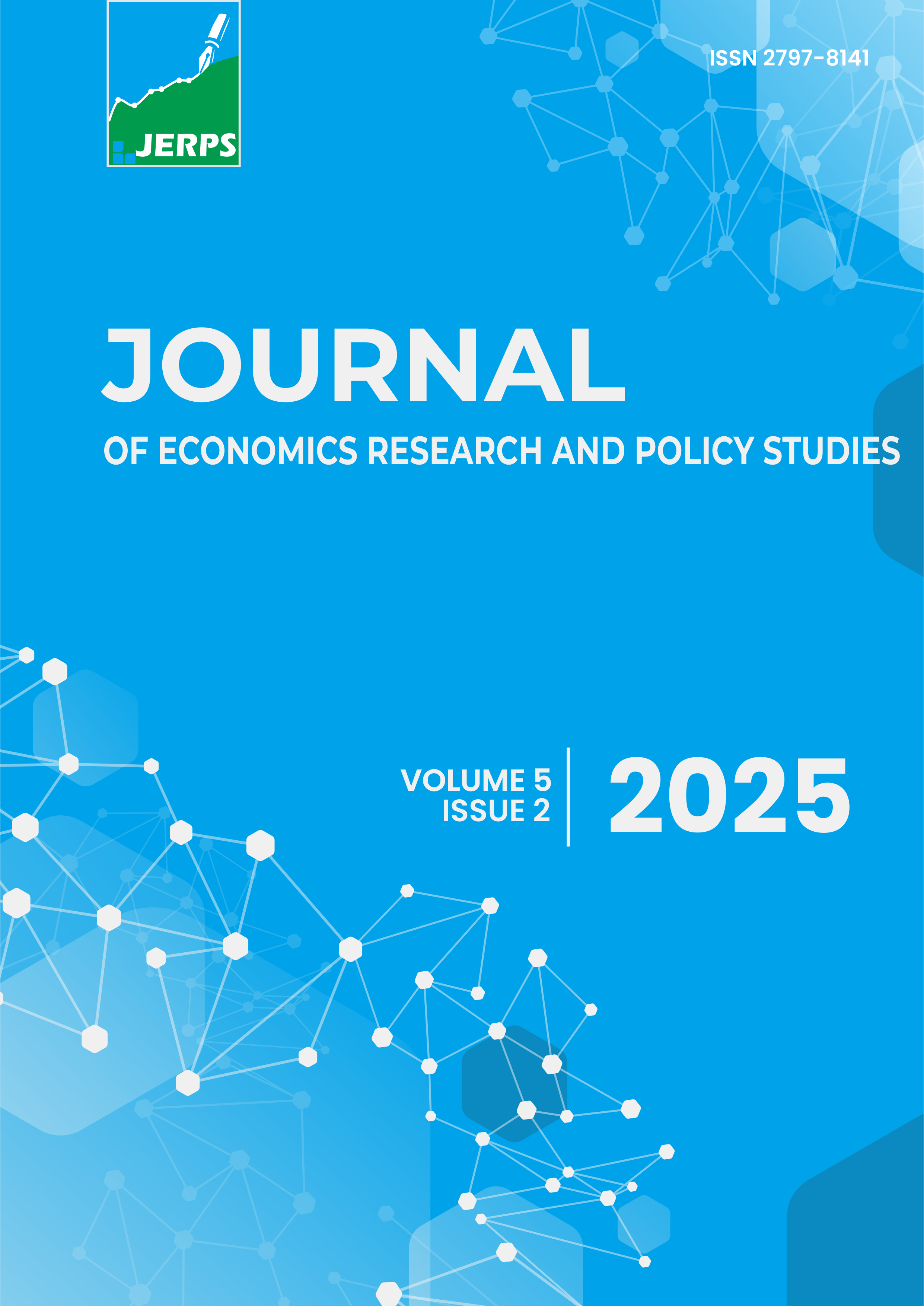Bidirectional relationships between inflation and key monetary indicators in Indonesia: Exploring short- and long-run dynamics
DOI:
https://doi.org/10.53088/jerps.v5i2.1985Keywords:
Inflation, Rupiah Exchange Rate, BI Rate, VAR/VECM, Money SupplyAbstract
This study aims to analyse the effect of money supply, rupiah exchange rate, and interest rate (BI Rate) on inflation, and vice versa, in Indonesia from 2016 to 2024, with a total of 100 observations. The method employed is a quantitative approach utilizing Vector Autoregression/Vector Error Correction Model (VAR/VECM) analysis techniques to identify both short-term and long-term effects. The results of the study indicate that the money supply and inflation do not significantly influence each other in either the short or long term. The exchange rate has a negative and significant influence on inflation in the long term. In contrast, the interest rate shows a positive and significant influence on inflation only in the long term. The results of the Impulse Response Function (IRF) and Variance Decomposition (VD) analyses confirm that the exchange rate is the most effective variable in explaining variations in inflation. In contrast, the roles of money supply and interest rates are relatively low. These findings indicate the importance of exchange rate stabilization as the primary strategy in controlling inflation in Indonesia.
References
Agustin, D. P. (2021). Analisis Pengaruh Tingkat Kurs Dan Suku Bunga Bank Indonesia Dengan Jumlah Uang Beredar, Terhadap Tingkat Inflasi Di Indonesia. Develop: Jurnal Ekonomi Pembangunan, 2(1), 33–46. Https://Doi.Org/10.53990/Djep.V2i1.105 DOI: https://doi.org/10.53990/djep.v2i1.105
Anilah, F., Kamillah, A., & Stiawan, D. (2023). Analisis Pengaruh Jumlah Uang Beredar Dan Kurs Rupiah Terhadap Inflasi di Indonesia. Journal Of Islamic Economics And Finance, 3(2), 85–94. https://doi.org/10.28918/jief.v3i2.1124 DOI: https://doi.org/10.28918/jief.v3i2.1124
Chandra, E. K., & Wahyuningsih, D. (2021). Analisis Pengaruh Suku Bunga, Jumlah Uang Beredar Dan Nilai Tukar Terhadap Inflasi Di Indonesia Periode 2011-2019. Buletin Ekonomika Pembangunan, 2(1), 37–54. https://doi.org/10.21107/bep.v2i1.13848
Elvina, M., Purnami, A. A. S., & Wulandari, I. G. A. A. (2021). Pengaruh Jumlah Uang Beredar (M1) Dan Suku Bunga Bi (Bi Rate) Terhadap Tingkat Inflasi Di Indonesia. Warmadewa Economic Development Journal (Wedj), 4(2), 47–52. https://doi.org/10.22225/wedj.4.2.2021.47-52 DOI: https://doi.org/10.22225/wedj.4.2.2021.47-52
Fadilla, & Aravik, H. (2018). Pandangan Islam Dan Pengaruh Kurs, Bi Rate Terhadap Inflasi. Jurnal Ecoment Global, 3(2), 95–108. https://doi.org/10.35908/jeg.v3i2.478 DOI: https://doi.org/10.35908/jeg.v3i2.478
Fatmawati, M. N. R., & Indah Yuliana. (2020). Bagaimana Dampak Transaksi Non Tunai Dan Inflasi Terhadap Jumah Uang Yang Beredar. JRMSI - Jurnal Riset Manajemen Sains Indonesia, 11(1), 130–148. https://doi.org/10.21009/jrmsi.011.1.07 DOI: https://doi.org/10.21009/JRMSI.011.1.07
Harahap, F. S. (2023). Pengaruh Kurs, Suku Bunga Sbi, Dan Jumlah Uang Beredar Terhadap Tingkat Inflasi Di Indonesia. Madani: Jurnal Ilmiah Multidisiplin, 1(5), 665–678. https://doi.org/10.5281/zenodo.8040895 DOI: https://doi.org/10.30743/jekkp.v5i1.7507
Mazaya, H. (2020). Analisis Pengaruh Jumlah Uang Beredar, Nilai Tukar Rupiah, Dan Suku Bunga Terhadap Inflasi Di Indonesia Periode 2005-2018. Jurnal Paradigma Multidisipliner, 1(2), 123–140. https://doi.org/10.1210/.v1i2.22 DOI: https://doi.org/10.21107/bep.v2i1.13848
Melisa, M., Ariffianti, I., Pratama, B. D., Arsana, I. N., & Nuada, I. W. (2022). Pengaruh Transaksi Non Tunai Terhadap Jumlah Uang Beredar Di Indonesia Dengan Inflasi Sebagai Variabel Moderasi. Media Bina Ilmiah, 17(1), 45-58. https://doi.org/10.33578/mbi.v17i1.108
Mishkin, F. S. (2009). The Economics Of Money, Banking And Financial Market (8th Ed.). Salemba Empat Jakarta.
Ningsih, S., & Kristiyanti, L. M. S. (2019). Analisis pengaruh jumlah uang beredar, suku bunga dan nilai tukar terhadap inflasi di Indonesia periode 2014-2016. Jurnal Manajemen Dayasaing, 20(2), 96-103. https://doi.org/10.23917/dayasaing.v20i2.7258
Panjaitan, P. D., Elidawaty Purba, & Darwin Damanik. (2021). Pengaruh Jumlah Uang Beredar Dan Nilai Tukar Terhadap Inflasi Di Sumatera Utara. Ekuilnomi: Jurnal Ekonomi Pembangunan, 3(1), 18–23. https://doi.org/10.36985/t2e4z357 DOI: https://doi.org/10.36985/t2e4z357
Sari, S. P., & Nurjannah, S. (2023). Analisis Pengaruh Nilai Tukar, Jumlah Uang Beredar Dan Bi Rate Terhadap Inflasi Di Indonesia Dan Dampaknya Terhadap Daya Beli Masyarakat. Aktiva: Journal Of Accountancy And Management, 1(1), 21–29. https://doi.org/10.24260/aktiva.v1i1.1015 DOI: https://doi.org/10.24260/aktiva.v1i1.1015
Sriwahyuni, A., Pinondang Nainggolan, & Anggiat Sinurat. (2020). Pengaruh Jumlah Uang Beredar, Suku Bunga Dan Nilai Tukar Terhadap Inflasi Di Sumatera Utara. Ekuilnomi : Jurnal Ekonomi Pembangunan, 2(2), 60–72. https://doi.org/10.36985/g2nfer65 DOI: https://doi.org/10.36985/ekuilnomi.v2i2.107
Sugiyono, Prof. Dr. (2019). Metode Penelitian Pendidikan : Kuantitatif, Kualitatif, Kombinasi, R&D Dan Penelitian Tindakan (3, Ed.). Bandung: Alfabeta.
Susmiati, S., Giri, N. P. R., & Senimantara, N. (2021). Pengaruh Jumlah Uang Beredar Dan Nilai Tukar Rupiah (Kurs) Terhadap Tingkat Inflasi Di Indonesia Tahun 2011-2018. Warmadewa Economic Development Journal (Wedj), 4(2), 68–74. Https://Doi.Org/10.22225/Wedj.4.2.2021.68-74 DOI: https://doi.org/10.22225/wedj.4.2.2021.68-74
Taufik, D. A. (2024). Analisis pengaruh jumlah uang beredar, suku bunga, dan nilai tukar terhadap tingkat inflasi di Indonesia periode tahun 2001-2020. Diponegoro Journal of Economics, 10(4), 372-386. https://doi.org/10.14710/djoe.32947 DOI: https://doi.org/10.14710/djoe.32947
Widyaningrum, M. N. (2024). Pengaruh Jumlah Uang Beredar, Suku Bunga Dan Nilai Tukar Terhadap Inflasi Di Indonesia Pada Tahun 2014-2023. Entrepreneur: Jurnal Bisnis Manajemen dan Kewirausahaan, 5(2), 114-125. https://doi.org/10.31949/entrepreneur.v5i2.9104 DOI: https://doi.org/10.31949/entrepreneur.v5i2.9104
Downloads
Published
How to Cite
Issue
Section
License
Copyright (c) 2025 Nur Azizah Amalia, Siti Fatimah Zahra, Fitra Dila Lestari

This work is licensed under a Creative Commons Attribution-ShareAlike 4.0 International License.
Authors who publish with this journal agree to the following terms:
The author(s) retain copyright and grant the journal the right of first publication with the work simultaneously licensed under a CC BY-SA 4.0 license that allows others to remix, adapt, and build upon the work even for commercial purposes, as long as they credit the author(s) and license their new creations under the identical terms.
License details: https://creativecommons.org/licenses/by-sa/4.0/


